Defence has been the bane of the Toronto Maple Leafs since day one of their rebuild. Four seasons later, and now legitimate Stanley Cup contenders, their defensive struggles persist.
After finishing 20th in goals against (3.04 per game) and 24th in shots against (33.1 per game), the Maple Leafs allowed 23 goals in seven games against the Boston Bruins en route to another first round playoff exit. They’ll be looking to improve on their greatest weakness heading into next season, but after losing arguably their best defenceman in Jake Gardiner it will be easier said than done.
In a previous article, we discussed internal replacements for Gardiner, including promising young defencemen like Travis Dermott, Timothy Liljegren, and Rasmus Sandin. This time, we’ll explore realistic trade targets that would bolster the Maple Leafs’ blue line.
The Maple Leafs’ Cap Situation
First things first: the Maple Leafs’ 2019-20 cap situation is dire to say the least. According to James Mirtle’s projection, the Leafs will have $1.1 million in cap space, and that’s factoring in a Connor Brown trade with no salary coming back.
Needless to say, any kind of meaningful trade to patch up the defence will require a significant piece moving out. The most likely candidate in such a case would be Nikita Zaitsev, who is slightly overpaid at $4.5 million for the next five seasons. Although his contract isn’t the most enticing, Zaitsev is still an NHL-quality defenceman who might be valued by more old-school general managers around the league. If he can be moved – something GM Kyle Dubas will surely try to pull off – then the Maple Leafs would have up to $5.6 million in cap space to work with. That’s plenty of room to bring in a strong top-four defender.
Trade Targets
Significant trades are always difficult to pull off in today’s NHL because there’s so much parity. In a league where it seems like almost any team can make the playoffs and win, general managers tend to be wary of making big moves. Instead of making a splash for a big name like P.K. Subban, the Maple Leafs may consider a more prudent approach by trading for an undervalued defenceman. Attempting to exploit market inefficiencies is something that the analytically-inclined Dubas is known for, and ideally, it keeps the cost down.
Justin Faulk
Justin Faulk may not qualify as undervalued, but he’s in an interesting position as the Carolina Hurricanes are exceptionally deep on defence. With a right side of Brett Pesce, Dougie Hamilton, and Faulk, the Hurricanes can afford to trade one away for some scoring help.
Despite ranking first this season in expected goals for with 275, Carolina finished 16th in actual goals for, scoring 243 times. They may be in the market for some shooting talent, and the offensively-stacked Maple Leafs could be the perfect trading partner.
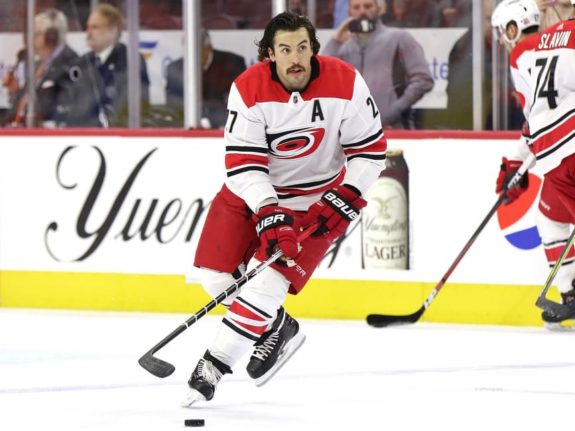
Faulk scored 11 goals and 35 points last season while averaging 22:25 of ice time. He’s under contract for one more season with an average annual value (AAV) of $4,833,333 – a perfect fit for the Maple Leafs if Zaitsev is traded. Faulk would immediately become the Maple Leafs’ best defenceman on the right side and would solidify their top-four. Re-signing him would be no issue either with Patrick Marleau’s $6.25 million coming off the books in 2020-21.
The only question is how well Faulk would fit in with the Maple Leafs’ personnel. He’s more of a power play specialist and doesn’t provide the defensive stability that the Maple Leafs might be looking for.
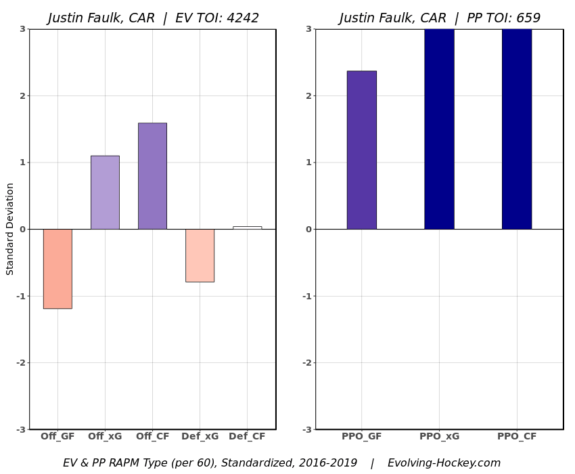
Radko Gudas
The gritty Philadelphia Flyers defenceman is known for his physical style of play and penchant for occasionally stepping over the line. What most fans don’t know, though, is that Gudas has consistently driven results over the course of his career.
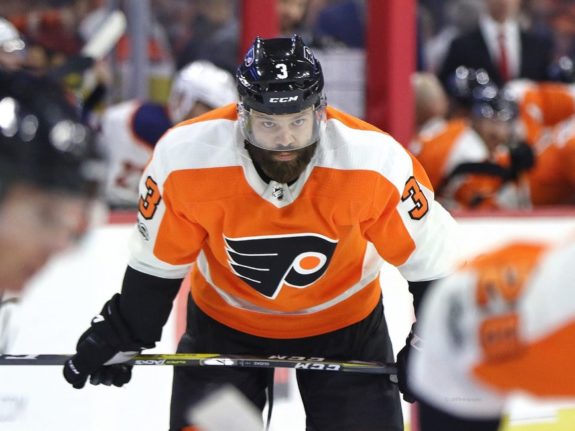
In 2018-19 he tallied four goals and 20 points while playing 17:53 per game. Over the last three seasons, Gudas has had a strong positive impact on shots and goals at both ends of the ice. His expected goals against (Def_xG) is impressive as he does a good job of keeping opponents to the outside, away from his net.

Right: 5v5 unblocked shot rates against Radko Gudas, 2018-19. From Hockeyviz.com
The 28-year-old would be a great fit for the Maple Leafs’ blue line which has been criticized for its lack of physicality and toughness. Stylistically, Gudas is the ideal partner for the high-octane Morgan Rielly, who excels offensively but struggles in his own end. Signed for one more season at an AAV of $3.35 million, he fits easily into the Maple Leafs’ budget.
Josh Manson
One player that has been connected to the Maple Leafs for a few years is Josh Manson. It’s been rumoured that the Maple Leafs were interested in him previously, but it may finally be the right time for Toronto to acquire the Prince Albert, Saskatchewan native. Manson has been an integral part of the Anaheim Ducks’ defensive corps for the last four seasons, but now with the team likely entering a rebuild they may be looking to extract some value from their veteran players.
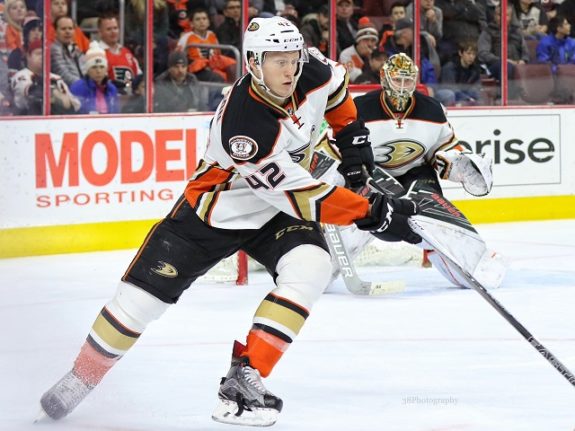
Manson put up three goals and 16 points while playing 22:15 per night in a down year for the Ducks, while his career-high 37 points came in 2017-18. The 6-foot-3 defenceman is best known for his strong defensive and physical play and is signed for three more seasons at $4.1 million. Disregarding the 2018-19 season (as Anaheim was a disaster), Manson has been an incredible defender with positive impacts all over the ice, and is a great penalty-killer to boot.
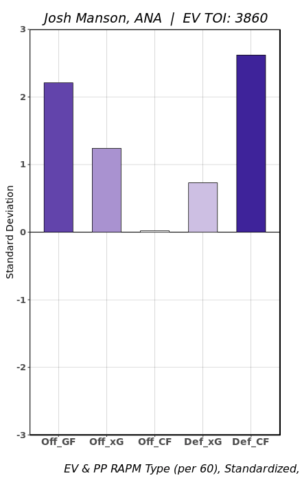
Colin Miller
Colin Miller is perhaps the most underrated player on this list, both by fans and even the Vegas Golden Knights’ coaching staff. Despite tallying 41 points and being the best defenceman on the team in 2017-18, Miller found himself benched several times this past season, finishing with three goals and 29 points in 65 games, averaging 19:39 of ice time. He was also benched for Game 1 of the playoffs against the San Jose Sharks, then emerged as an impact player once being injected back into the lineup.

Interestingly, Miller played for the Soo Greyhounds of the Ontario Hockey League from 2010-2013, when Dubas was general manager of the team. The Sault Ste. Marie connection may provide further basis for Dubas to pursue a player he’s familiar with.
Like the other trade targets, Miller has a track record of positive impacts on both offence and defence and like Gudas, he is able to limit scoring chances against by keeping opposing forwards away from his net.

Right: 5v5 unblocked shot rates against Colin Miller, 2018-19. From Hockeyviz.com
Miller just re-signed with Vegas last July, so they may be unwilling to part with a newly-signed player. However, his cap hit of $3,875,000 is particularly appealing for what he brings to his team, and the Maple Leafs should be calling to kick their tires.
Standing Pat: The Other Approach
The Maple Leafs ultimately have two approaches when it comes to permanently fixing their blue line, and each option has its own pros and cons.
The first option, as outlined above, would be to trade for one of the aforementioned players or someone else they deem valuable. The benefit of a trade is obvious: you’re getting a good player that fits into your lineup and makes your team better immediately. The downside is that you’re giving up significant roster pieces or highly-rated prospects.
Otherwise, the Maple Leafs can stand pat with their current roster and wait for their prospects to develop. The benefit of this is that they wouldn’t have to trade away any valuable pieces. On the other hand, it’s hard to tell how good Dermott will become, and how soon Liljegren and Sandin will be able to make the jump to the NHL. For a contending team with Stanley Cup aspirations, the waiting game may not be the best option.
Regardless of what the Maple Leafs decide, Dubas should be doing his due diligence this summer by making calls around the league to find out who is available and for what price. It’s always difficult to trade good players away, but the Maple Leafs need to address their defensive woes sooner or later if they want to get over the first-round playoff hump.
Team stats from TSN.ca
Player stats from naturalstattrick.com and hockey-reference.com
Salary cap info from capfriendly.com